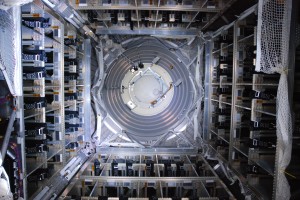Not your average spring cleaning
 When ATV Albert Einstein docks with the International Space Station, it will bring fresh food and water and then serve as a habitable module for the astronauts aboard. Nobody wants to bring fungi or bacteria to Station, so guidelines have been set on the level of cleanliness expected on all equipment used in human spaceflight.
When ATV Albert Einstein docks with the International Space Station, it will bring fresh food and water and then serve as a habitable module for the astronauts aboard. Nobody wants to bring fungi or bacteria to Station, so guidelines have been set on the level of cleanliness expected on all equipment used in human spaceflight.
The task of scrubbing ATV clean has gone to ESA’s Life and Physical Sciences Instrumentation and Life Support team since the launch of the first ATV vessel, ATV Jules Verne, in 2008.
The team is part of a multidisciplinary group based at ESA’s European Space Research and Technology Centre (ESTEC) who regularly work on developing a closed Life Support System, MELiSSA.
MELiSSA intends to produce oxygen, water and food by recycling mission waste. Knowledge gained from understanding, running and controlling microbiological processes as part of this project is used to ensure ATV’sPressurised Module reaches the necessary level of microbial cleanliness.
Scroll down (after the jump) for a fabulous behind-the-scenes video tour of the disinfection process of ATV Albert Einstein.
Super duper preview… more after the jump!
Shortly before launch, a selection of enthusiastic team members travel to Kourou, French Guiana, to disinfect ATV’s Pressurised Module. Those who imagine a pleasant mission to the tropical beaches of equatorial South America with a bit of light cleaning on a real spaceship will be heavily disappointed.
First up: preparation of the disinfection materials. Medical-grade cotton swabs and gauze are soaked in 6% hydrogen peroxide, the same product used to turn hair blonde. Disinfecting a vehicle the size of a double-decker bus with cotton swabs is a daunting task and requires lots of patience and… many cotton swabs.
Two whole days are spent repeatedly dipping the materials in peroxide solution under negative air pressure to make sure no dust is added to the mix.
Then to work!
… and work!
After around 600 wipes and swabs have been dipped and folded, it is time to enter the clean room where ATV is readied for launch. Much like surgeons before an operation, the cleaning team don scrubs, hair nets and covers over their shoes and gloves.
A quick glance at the exterior of the beast is recommended to get an impression of scale. The video below was shot in December before ATV Albert Einstein’s service module was attached to the pressurised model that the astronauts can enter in space.
And more work!
Every nook and cranny of the empty ATV cargo hold must be wiped clean with the prepared clothes and cotton swabs. The video below demonstrates the extent of cleaning expected; each part of ATV has a purpose, but the MELIiSSA team secretly curse the designers who included all the belts, ridges, depressions, nuts, bolts, cavities and hard-to-reach areas.
In the interest of speed, up to three team members can work at the same time, dividing their efforts. Getting everything clean within the deadline is the hardest part of this work. While wiping is in progress, all other work on ATV must stop and the clock is ticking to get Albert Einstein launched.
Avoid dropping cotton swabs as they can fall through the cargo racks on the floor and must be removed before launch. Dedicated instruments are available to retrieve swabs that have fallen into cracks, but retrieving them is time-consuming and difficult.
When the two sides have been thoroughly wiped, ATV is turned a quarter-turn and the process can start again on what was the ceiling and floor previously.
After more hours spent in ATV’s cargo hold, the cargo proper can be loaded to be followed by another round of… disinfection.
Almost finished – but the hatch needs a thorough wipe before the team call it a day.
Microbial samples collected by the team are analysed by the Institute Pasteur de la Guyane to validate the efficiency of the disinfection process and to assess the level of microbial cleanliness as well as identify any microorganisms recovered.
After days of intensive, repetitive, back-breaking, invisible-to-the-naked-eye work, ATV is as clean as it will ever be, free of the nasty pathogens that could harm astronauts in space.
For the team, it is the end of some very long working days spent over the Christmas holidays away from family and friends in a room without sunlight or even a radio.

 Automated Transfer Vehicle page
Automated Transfer Vehicle page ATV blog archive
ATV blog archive
Discussion: no comments